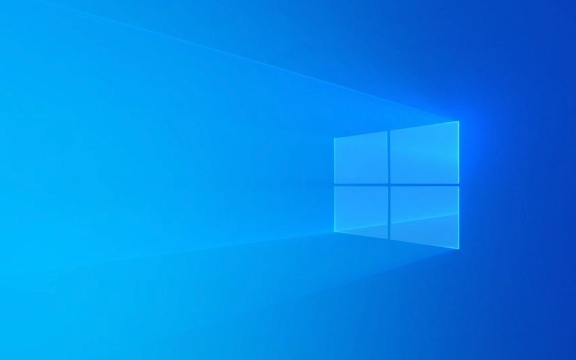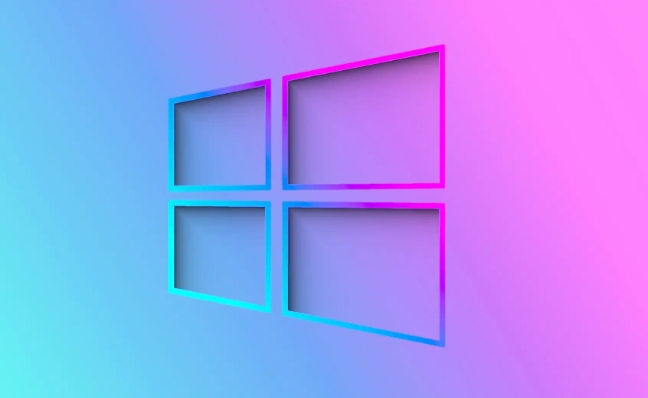 Computer Tutorials
Computer Tutorials
 Troubleshooting
Troubleshooting
 how to fix win error 0x80070035 'the network path was not found'
how to fix win error 0x80070035 'the network path was not found'
how to fix win error 0x80070035 'the network path was not found'
Aug 01, 2025 am 06:15 AMFirst, confirm that the problem that the network path cannot be found is usually caused by connectivity, name resolution or sharing settings. 1. Enable network discovery and file and printer sharing and turn off password protection sharing; 2. Verify the target computer name and IP connectivity, and directly access through ping test or using the IP address; 3. Temporarily enable SMB 1.0 if necessary, but it is recommended to use SMBv2/v3 first; 4. Ensure that key services such as Function Discovery, Server, Workstation are running and the firewall allows file and printer sharing; 5. If there is a name resolution problem, you can use FQDN or add entries in the hosts file; 6. Set the network configuration file to "dedicated" to enable discovery; 7. Restart the computer and network devices to refresh the connection; finally confirm that all settings are correct through the checklist to confirm that all settings are correct.

The error 0x80070035 – "The network path was not found" in Windows usually occurs when you're trying to access a shared folder or computer on your network, but Windows can't locate or reach the target device. This is common when using File Explorer to access \\ComputerName or when setting up network file sharing.

Here's how to fix it step by step:
1. Check Network Discovery and File Sharing Settings
Make sure both computers are on the same network and that network discovery is enabled.

Steps:
- Press
Win I→ Go to Network & Internet → Advanced network settings → Advanced sharing settings . - Under Private networks , ensure these options are turned on:
- Turn on network discovery
- Turn on file and printer sharing
- Turn on HomeGroup connections (if applicable)
- For all networks , make sure:
- Turn off password protected sharing (if you're on a trusted network and want easy access)
? Tip: If you're on a domain, some settings may be controlled by group policies.

2. Verify the Target Computer Name and Network Connectivity
The error often means the system can't resolve the computer name.
Do this:
- On the computer you're trying to access, check its name:
-
Win I→ System → About → Device name
-
- From your current PC, try pinging that name:
ping ComputerName
Or if you know the IP:
ping 192.168.1.100
- If the name doesn't resolve, try using the IP address instead:
- Instead of
\\ComputerName, use\\192.168.1.100
- Instead of
? If ping fails, the devices aren't communicating — check Wi-Fi/Ethernet, router, or firewall.
3. Enable SMB 1.0 (Not Recommended, but Sometimes Needed)
Some older systems or devices (like NAS drives) may still rely on SMBv1. However, SMBv1 is outdated and insecure , so only enable it if absolutely necessary.
To enable (temporarily):
- Open Control Panel → Programs → Turn Windows features on or off
- Check:
- ? SMB 1.0/CIFS File Sharing Support
- ? SMB 1.0/CIFS Client
- Click OK and restart.
?? After testing, disable it again for security.
Better: Ensure both devices support SMBv2 or SMBv3 . Most modern Windows versions (8/10/11) use SMBv3 by default.
4. Check Services and Firewall Settings
Certain Windows services must be running for network sharing to work.
Required services:
- Function Discovery Provider Host
- Function Discovery Resource Publication
- Computer Browser (if applicable)
- Server
- Workstation
To check:
- Press
Win R, typeservices.msc, and hit Enter. - Look for the above services and ensure their status is Running .
Also, make sure:
- Windows Defender Firewall isn't blocking file and printer sharing.
- In Windows Security → Firewall & network protection → Allow an app through firewall , verify that File and Printer Sharing is allowed for Private (and maybe Public) networks.
5. Use FQDN or Add Hosts Entry (Advanced)
If name resolution is failing, you can:
- Use the full name:
\\ComputerName.local(on home networks using mDNS) - Or edit the hosts file:
- Open
C:\Windows\System32\drivers\etc\hostsin Notepad (as Admin) - Add a line:
192.168.1.100 ComputerName
This helps if DNS/netbios resolution is broken.
6. Ensure Both Devices Are on the Same Network Profile (Private)
Windows treatments Public networks as unsafe and disables discovery.
- Go to Settings → Network & Internet → Wi-Fi → [Your Network]
- Set network profile to Private
This allows the PC to be discovered.
7. Restart Network Devices
Sometimes a simple reset helps:
- Restart both computers
- Restart your router or switch
- Reconnect to the network
Summary Checklist
- ? Both PCs on same network (and subnet)
- ? Network discovery and file sharing enabled
- ? Target computer name or IP is correct
- ? Can ping the other machine
- ? Required services are running
- ? Firewall allows file sharing
- ? Network set to Private
- ? SMB version compatible (prefer SMBv2/v3)
Fixing 0x80070035 usually comes down to connectivity , name resolution , or sharing settings . Start with ping and using IP addresses — that often reveals the real issue.
The above is the detailed content of how to fix win error 0x80070035 'the network path was not found'. For more information, please follow other related articles on the PHP Chinese website!
- Open

Hot AI Tools

Undress AI Tool
Undress images for free

Undresser.AI Undress
AI-powered app for creating realistic nude photos

AI Clothes Remover
Online AI tool for removing clothes from photos.

Clothoff.io
AI clothes remover

Video Face Swap
Swap faces in any video effortlessly with our completely free AI face swap tool!

Hot Article

Hot Tools

Notepad++7.3.1
Easy-to-use and free code editor

SublimeText3 Chinese version
Chinese version, very easy to use

Zend Studio 13.0.1
Powerful PHP integrated development environment

Dreamweaver CS6
Visual web development tools

SublimeText3 Mac version
God-level code editing software (SublimeText3)
 Windows Security is blank or not showing options
Jul 07, 2025 am 02:40 AM
Windows Security is blank or not showing options
Jul 07, 2025 am 02:40 AM
When the Windows Security Center is blank or the function is missing, you can follow the following steps to check: 1. Confirm whether the system version supports full functions, some functions of the Home Edition are limited, and the Professional Edition and above are more complete; 2. Restart the SecurityHealthService service to ensure that its startup type is set to automatic; 3. Check and uninstall third-party security software that may conflict; 4. Run the sfc/scannow and DISM commands to repair system files; 5. Try to reset or reinstall the Windows Security Center application, and contact Microsoft support if necessary.
 Windows stuck on 'undoing changes made to your computer'
Jul 05, 2025 am 02:51 AM
Windows stuck on 'undoing changes made to your computer'
Jul 05, 2025 am 02:51 AM
The computer is stuck in the "Undo Changes made to the computer" interface, which is a common problem after the Windows update fails. It is usually caused by the stuck rollback process and cannot enter the system normally. 1. First of all, you should wait patiently for a long enough time, especially after restarting, it may take more than 30 minutes to complete the rollback, and observe the hard disk light to determine whether it is still running. 2. If there is no progress for a long time, you can force shut down and enter the recovery environment (WinRE) multiple times, and try to start repair or system restore. 3. After entering safe mode, you can uninstall the most recent update records through the control panel. 4. Use the command prompt to execute the bootrec command in the recovery environment to repair the boot file, or run sfc/scannow to check the system file. 5. The last method is to use the "Reset this computer" function
 Proven Ways for Microsoft Teams Error 657rx in Windows 11/10
Jul 07, 2025 pm 12:25 PM
Proven Ways for Microsoft Teams Error 657rx in Windows 11/10
Jul 07, 2025 pm 12:25 PM
Encountering something went wrong 657rx can be frustrating when you log in to Microsoft Teams or Outlook. In this article on MiniTool, we will explore how to fix the Outlook/Microsoft Teams error 657rx so you can get your workflow back on track.Quick
 The RPC server is unavailable Windows
Jul 06, 2025 am 12:07 AM
The RPC server is unavailable Windows
Jul 06, 2025 am 12:07 AM
When encountering the "RPCserverisunavailable" problem, first confirm whether it is a local service exception or a network configuration problem. 1. Check and start the RPC service to ensure that its startup type is automatic. If it cannot be started, check the event log; 2. Check the network connection and firewall settings, test the firewall to turn off the firewall, check DNS resolution and network connectivity; 3. Run the sfc/scannow and DISM commands to repair the system files; 4. Check the group policy and domain controller status in the domain environment, and contact the IT department to assist in the processing. Gradually check it in sequence to locate and solve the problem.
 the default gateway is not available Windows
Jul 08, 2025 am 02:21 AM
the default gateway is not available Windows
Jul 08, 2025 am 02:21 AM
When you encounter the "DefaultGatewayisNotAvailable" prompt, it means that the computer cannot connect to the router or does not obtain the network address correctly. 1. First, restart the router and computer, wait for the router to fully start before trying to connect; 2. Check whether the IP address is set to automatically obtain, enter the network attribute to ensure that "Automatically obtain IP address" and "Automatically obtain DNS server address" are selected; 3. Run ipconfig/release and ipconfig/renew through the command prompt to release and re-acquire the IP address, and execute the netsh command to reset the network components if necessary; 4. Check the wireless network card driver, update or reinstall the driver to ensure that it works normally.
 How to fix 'SYSTEM_SERVICE_EXCEPTION' stop code in Windows
Jul 09, 2025 am 02:56 AM
How to fix 'SYSTEM_SERVICE_EXCEPTION' stop code in Windows
Jul 09, 2025 am 02:56 AM
When encountering the "SYSTEM_SERVICE_EXCEPTION" blue screen error, you do not need to reinstall the system or replace the hardware immediately. You can follow the following steps to check: 1. Update or roll back hardware drivers such as graphics cards, especially recently updated drivers; 2. Uninstall third-party antivirus software or system tools, and use WindowsDefender or well-known brand products to replace them; 3. Run sfc/scannow and DISM commands as administrator to repair system files; 4. Check memory problems, restore the default frequency and re-plug and unplug the memory stick, and use Windows memory diagnostic tools to detect. In most cases, the driver and software problems can be solved first.
 Windows 11 KB5062660 24H2 out with features, direct download links for offline installer (.msu)
Jul 23, 2025 am 09:43 AM
Windows 11 KB5062660 24H2 out with features, direct download links for offline installer (.msu)
Jul 23, 2025 am 09:43 AM
Windows 11 KB5062660 is now rolling out as an optional update for Windows 11 24H2 with a few new features, including Recall AI in Europe. This patch is available via Windows Update, but Microsoft has also posted direct download l
 How to repair Windows 11 using command prompt
Jul 05, 2025 am 02:59 AM
How to repair Windows 11 using command prompt
Jul 05, 2025 am 02:59 AM
How to use command prompt to repair Windows 11? 1. Enter the command prompt through the recovery environment: enter the recovery environment through USB boot or three consecutive interrupts, and then select Troubleshooting > Advanced Options > Command Prompt; 2. Use DISM to repair the system image: Run DISM/Online/Cleanup-Image/CheckHealth to check for corruption, DISM/Online/Cleanup-Image/ScanHealth scanning problem, DISM/Online/Cleanup-Image/RestoreHealth to repair the problem, and specify an external source if necessary; 3. Run SF






